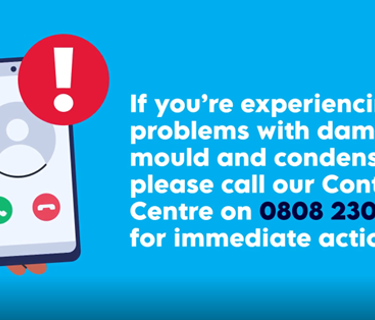Damp, mould and condensation can all make your home less pleasant and unsightly to live in, but sometimes it can be difficult to pin down the cause
In modern, well-insulated homes, condensation is often the main cause of mould in the home.
Condensation is simply moisture in your home which hasn’t been able to escape – the moisture can be created through cooking, drying clothes, showering and even breathing.
If you’re unsure whether you have damp and mould, please call us on 0808 230 6500 and the Contact Centre and the team will be able to help. Examples of the categories of damp and mould can be found here.
Simple steps to help avoid moisture build-up
- Wipe down surfaces where moisture settles
- Cover boiling pans when cooking
- Cover fish tanks to stop water evaporating
- Dry clothes outside when possible, or in a small room with the window open
- Make sure tumble dryers are ventilated to the outside
- Open windows or use extractor fans to let cooking steam escape (and do this for 20 minutes after cooking)
- Open windows for a while each day, or use trickle vents
- Leave a space between furniture and walls so air can circulate
- Don’t overfill cupboards and wardrobes, so there’s space for air to flow
- Keep air vents free from obstructions
- Maintain a low heat in your home when it’s cold or wet
- Close kitchen and bathroom doors when you’re cooking, bathing or washing.
If you have condensation in your home and make these changes, you should notice an improvement within four to six weeks.
Awaab's Law
All social landlords must now comply with the regulations of Awaab’s Law, addressing all emergency hazards and all damp and mould hazards that present a significant risk of harm to residents within fixed timescales.
Awaab’s Law is named in memory of two-year old Awaab Ishak, who tragically passed away on 21 December 2020, with the inquest into his death concluding that he died as a result of prolonged exposure to mould in his Rochdale Boroughwide Housing social home. The law, which was prompted by the inquest, gives residents new protections and rights, with social landlords now required to follow legally enforced timescales when it comes to cases of damp and mould.
The primary legislation was first introduced through the Social Housing (Regulation) Act 2023 which inserts into social housing tenancy agreements a term that requires social landlords to comply with the requirements that are set out in these Regulations.
The Law is being introduced with a phased approach, with the first phase starting in October 2025, covering all damp and mould hazards and emergency hazards, and in 2026, requirements will expand to apply to a wider range of health hazards. In 2027, the requirements will expand further to the remaining hazards as defined by the Housing Health and Safety Rating System (HHSRS).
Despite the phased approach, we’ll continue to meet our legal duties to keep all homes safe by carrying out our repairs in line with our published repairing timescales, ensuring that everyone has a clean, comfortable, safe and secure affordable place to live, free of dangerous health or safety hazards.
We will investigate all reports of damp and mould within 10 working days. Following the investigation, residents will receive a written summary of our findings and actions which will be taken within three days of completing the investigation.
The investigation may consist of a physical inspection of the property, or by asking a series of questions about the resident and household members and the extent of the damp and mould.
If the damp and mould is found to be dangerous (an emergency) upon inspection by the Damp and Mould team, we will complete the investigation and make it safe within 24 hours. If we are unable to make it safe, we will find alternative accommodation for the residents and household members, regularly keeping them informed of the next steps and progress of the works within the home.
Our emergency obligations:
Within 24 hours: Investigate the hazard and take action to make the property safe
Within 3 working days: Provide a written summary of your investigation and actions taken
Unable to make safe: Offer residents suitable alternative accommodation immediately
Our significant hazard obligations:
Within 10 working days: Complete a thorough investigation of the reported hazard
Within 3 working days of investigation: Provide a written summary of findings
Within 5 working days of investigation: Begin any necessary remedial works
If works can’t begin within 5 working days: Works must physically start and be completed within 12 weeks maximum
Our Repairs webpage details the categories and the fixed timeframes that we are required to follow in relation to the different hazards.
For this video to work, you will need to enable the cookies on this website. You can do this by updating your cookie settings at the bottom of this page. Alternatively, you can watch the video on YouTube here.
If you’re already following our guidelines and can see a ‘tidemark’ in the area, you may have a damp problem. This can be caused by things like:
- Leaking pipes, wastes or overflows
- Rain getting in where a roof tile or slate is missing
- Spillage from a blocked gutter
- Water entering around window frames.




